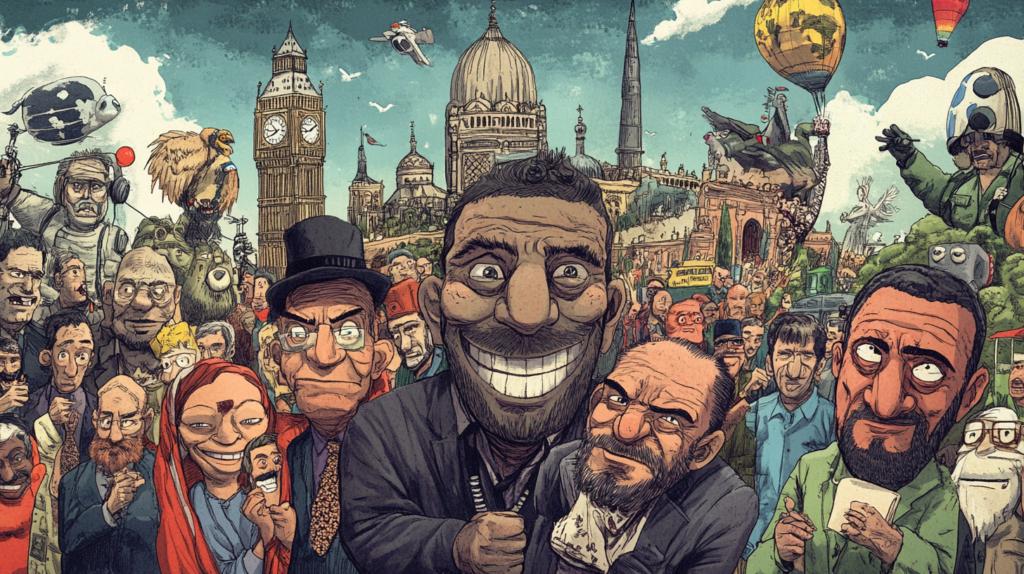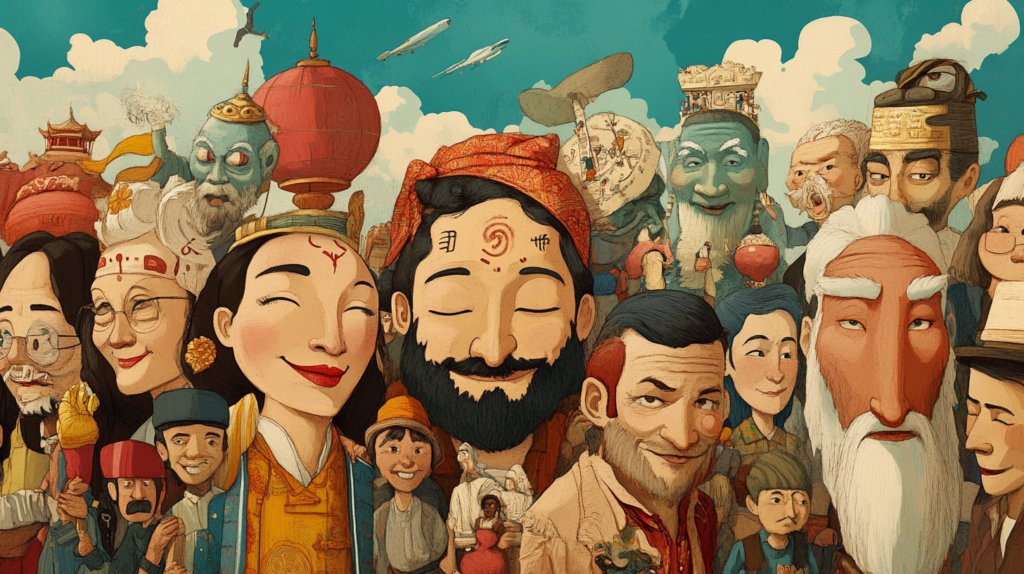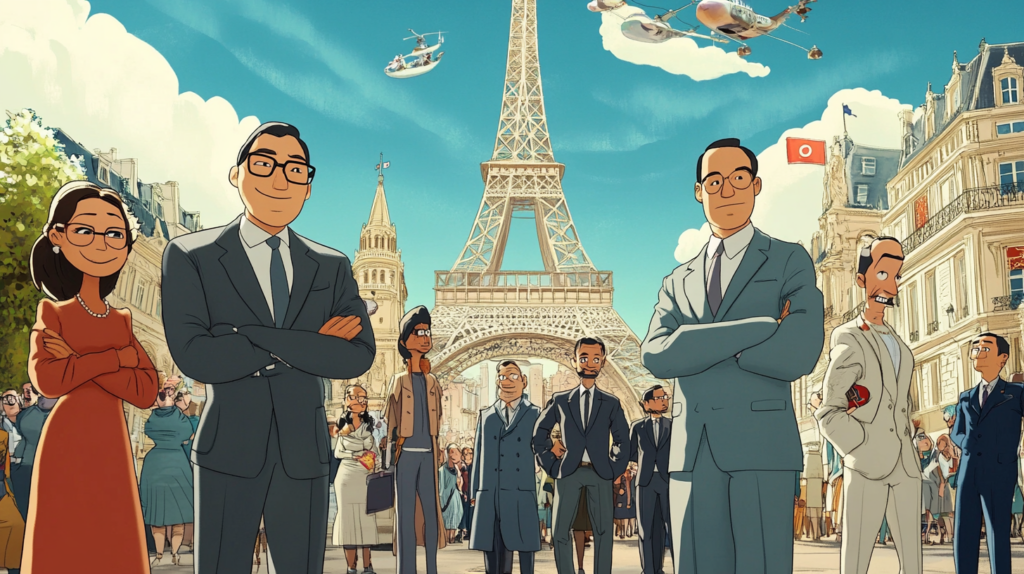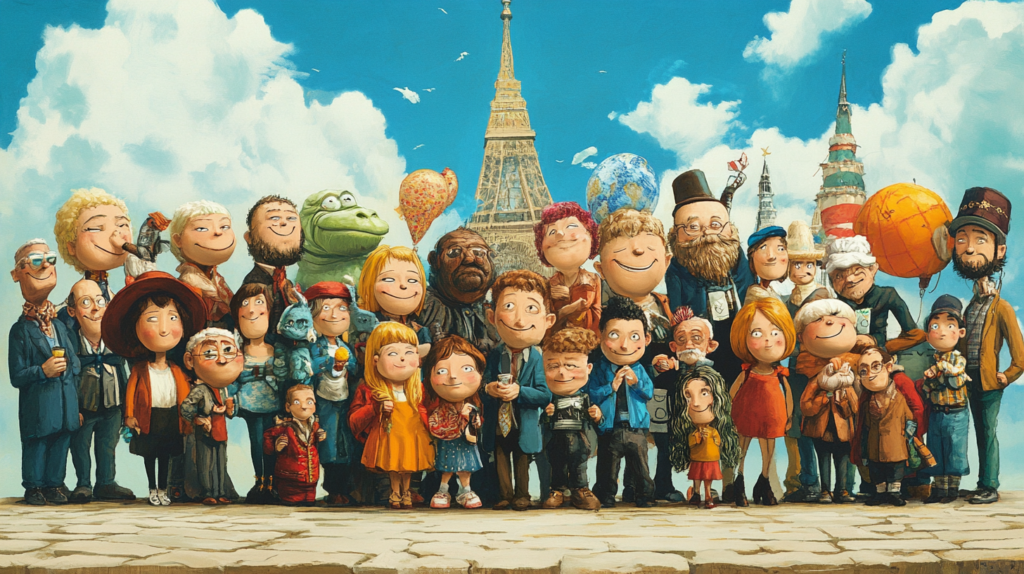Exploring Cultural Differences in International Cartoons: Cartoons have long served as a universal language—transcending spoken words to communicate stories, humor, and values through visuals and motion. Yet beneath the surface of what might seem like light-hearted entertainment lies a rich tapestry of cultural differences. From the meticulously hand-drawn anime of Japan to the bold, satirical caricatures found in European comics, international cartoons reflect the diverse traditions, social norms, and historical experiences of their creators. In this in-depth exploration, we delve into the evolution and impact of cartoons across different cultures, examining how they both mirror and shape societal perceptions, bridge cultural divides, and sometimes even spark controversy.
This journey into the world of international cartoons will reveal not only the artistic diversity of animation but also its power as a tool for cultural dialogue and exchange.
1. Cartoons as a Cultural Mirror
Cartoons have always been more than just entertainment—they are cultural artifacts. Whether conveying political satire, reinforcing national myths, or simply celebrating the quirks of everyday life, cartoons capture the essence of a society’s values and ideologies. Their ability to use imagery, humor, and symbolism makes them ideal vehicles for expressing cultural identity. International cartoons, by virtue of emerging from different social and historical contexts, offer us unique windows into the worldviews of various cultures.
For instance, Japanese anime is renowned for its blend of fantastical storytelling and deep philosophical undertones. In contrast, Western cartoons often rely on slapstick humor and clear-cut moral narratives. Even within regions, differences abound: European comics such as France’s bandes dessinées mix literary sophistication with striking visuals, while African and indigenous cartoons frequently draw on oral storytelling traditions and local folklore. As we examine these diverse forms, it becomes evident that cartoons both reflect and shape cultural identity.

2. A Brief History of International Cartoons
2.1 The Early Days of Animation
The origins of cartoons can be traced back to the early 20th century when simple hand-drawn sketches were animated frame-by-frame. Early animations were often experimental, focusing on movement and visual spectacle rather than deep narratives. In America, pioneering studios like Disney and Warner Bros. laid the groundwork for a style that would become synonymous with American pop culture. Characters like Mickey Mouse and Bugs Bunny were designed with exaggerated features and universal appeal in mind—ensuring that even without dialogue, their images conveyed clear messages.
Simultaneously, countries outside the United States were developing their own approaches to animation. In Europe, early cartoonists embraced caricature and satire to comment on political and social issues. These early cartoons often featured bold, expressive art and a sense of irony that resonated with audiences. In Asia, traditional art forms influenced the nascent animation industry. Chinese ink-wash techniques and Japanese woodblock prints provided a distinct aesthetic that set Asian animation apart from its Western counterparts.
2.2 The Golden Age and the Rise of Regional Styles
As animation technology improved and the medium gained popularity, distinct regional styles began to emerge. The Golden Age of American animation in the 1930s and 1940s saw the refinement of character design and narrative techniques. Meanwhile, Japanese anime, beginning in the post-war era, developed its own conventions—characterized by large, expressive eyes, fluid motion, and a narrative depth that explored complex themes like honor, duty, and existentialism. The rise of anime not only transformed the global animation landscape but also set the stage for international cultural exchange.
European animation also flourished during this period, with countries like France and Belgium producing influential comic strips and graphic novels. The bandes dessinées tradition, characterized by intricate artwork and layered storytelling, became a significant cultural force in Europe. Meanwhile, in regions such as Southeast Asia, local animators began to create content that resonated with their own experiences, blending traditional folklore with modern humor.
2.3 The Digital Revolution and Globalization
The advent of digital animation in the late 20th century revolutionized the industry. Modern software allowed for smoother motion, more detailed textures, and dynamic color palettes. This digital revolution not only enhanced the visual quality of cartoons but also democratized the medium—making it possible for creators from around the world to produce high-quality animation on a smaller budget.
Globalization further accelerated the spread of international cartoons. With the rise of the internet and streaming platforms, audiences gained unprecedented access to animated content from every corner of the globe. Today, a viewer in Norway might watch Japanese anime on Netflix while also enjoying European satirical cartoons on YouTube. This global distribution has spurred creative collaborations and cultural exchange, as animators adapt and reinterpret traditional themes to suit a broader audience.
3. Regional Influences on Cartoon Artistry
3.1 Asian Animation: Depth, Emotion, and Philosophical Inquiry
Asian animation, particularly from Japan, has made a profound impact on the global stage. Anime is characterized by its meticulous artistry, complex characters, and narratives that often incorporate elements of Eastern philosophy. Series like Avatar: The Last Airbender (an American production heavily influenced by Asian art and martial arts) and films by Studio Ghibli exemplify how Eastern aesthetics and storytelling techniques can evoke deep emotions and philosophical contemplation.
The influence of traditional Chinese art can also be seen in Asian animation. For example, movies like Big Fish & Begonia and Spirited Away draw heavily from Chinese and Japanese folklore, respectively. These films use symbolic imagery—such as color palettes that evoke seasonal changes or specific cultural symbols like red for good luck—to communicate themes of transformation, memory, and the cyclical nature of life. In these works, animation is not only a visual feast but also a means to convey cultural narratives deeply rooted in history and tradition.
3.2 European Cartoons: Satire, Sophistication, and Literary Allusions
European animation boasts a rich tradition of combining visual artistry with sophisticated narrative techniques. The Franco-Belgian comic tradition, or bandes dessinées, has produced iconic characters such as Tintin and Asterix. These works are renowned for their detailed artwork, intricate plots, and satirical commentary on social and political issues. European cartoons often employ humor that is both clever and subversive, challenging viewers to think critically about the world around them.
Moreover, European animation tends to incorporate literary allusions and historical references. For instance, many European cartoons subtly reference classical art and literature, creating a multi-layered experience that rewards attentive viewers. This blend of high art and popular culture has cemented European cartoons as culturally significant works that transcend mere entertainment.
3.3 African and Indigenous Animation: Oral Traditions and Cultural Resilience
In Africa and among indigenous populations worldwide, animation often serves as an extension of traditional storytelling. These cultures have long relied on oral traditions, masks, and performance art to pass down stories from one generation to the next. Modern animators from these regions draw on these rich traditions to create works that celebrate their heritage while addressing contemporary issues.
African animations frequently incorporate vibrant colors, rhythmic movements, and symbolic imagery drawn from local folklore. They are a powerful medium for addressing social issues, preserving cultural memory, and fostering community pride. Similarly, indigenous animations in the Americas and elsewhere often highlight themes of identity, resilience, and the interconnectedness of nature and humanity. By portraying traditional customs and rituals with authenticity and respect, these animations contribute to a broader understanding of cultural diversity in a globalized world.
4. Localization and Cultural Adaptation in Cartoons
4.1 The Art of Localization
Localization is the process of adapting content to suit the cultural, linguistic, and social norms of a particular region. In international cartoons, localization goes far beyond mere translation. It involves reinterpreting jokes, modifying cultural references, and sometimes even altering character designs to resonate with local audiences. For instance, when American cartoons like The Simpsons are adapted for non-English speaking regions, voice acting, idiomatic expressions, and even character names are adjusted to fit local sensibilities.
A notable example is the adaptation of The Simpsons into Arabic. The show’s dialogue is not only translated but also culturally adapted—references to American pop culture are modified or removed, and character names are sometimes altered to reflect local language and culture. This process of cultural adaptation is a delicate balancing act: it must honor the original work while ensuring that it is accessible and meaningful to a new audience.
4.2 Challenges of Cross-Cultural Representation
Despite the best efforts of localizers, cross-cultural representation in cartoons can be fraught with challenges. Stereotypes and cultural clichés may inadvertently be reinforced if not handled sensitively. For instance, early American cartoons often depicted non-Western cultures in simplistic or demeaning ways. Similarly, local adaptations may sometimes strip away the nuances of the original work, leading to a loss of cultural context.
However, these challenges also present opportunities for growth and dialogue. By engaging cultural consultants and diverse creative teams, animators can create works that are both globally accessible and deeply respectful of local traditions. This collaborative approach not only enhances the quality of the animation but also fosters mutual understanding between cultures.
4.3 Success Stories in Localization
Some international cartoons have successfully navigated the complexities of localization to create a global appeal. Japanese anime, for example, has been widely adapted for Western audiences while retaining its distinctive style and thematic depth. Series such as Naruto and One Piece have undergone extensive localization, with translators and voice actors working to preserve the original meaning while making the dialogue natural for new audiences.
Similarly, Disney’s efforts to produce te reo Māori dubs of its films demonstrate how localization can serve as a tool for cultural revitalization. By adapting beloved films into an indigenous language, Disney not only broadens its audience but also supports cultural preservation. This approach has been met with both enthusiasm and controversy, highlighting the power of localization in shaping cultural narratives.
5. Stereotypes, Humor, and the Role of Cartoons in Cultural Critique
5.1 Humor as a Cultural Lens
Humor is a universal aspect of human communication, yet what is considered funny can vary dramatically between cultures. Cartoons, with their reliance on visual and situational comedy, offer a unique perspective on how different societies use humor to comment on social norms, political issues, and everyday life. In some cultures, subtle satire and irony are highly valued, while in others, slapstick and exaggeration dominate. By comparing how humor is deployed in international cartoons, we gain insight into the cultural priorities and values of each society.
For instance, European cartoons often employ dry, sardonic wit and cultural allusions that require a certain level of literary or historical knowledge. In contrast, many American cartoons emphasize fast-paced, physical comedy and straightforward narratives. Asian animations, meanwhile, frequently blend humor with poignant emotional moments, reflecting a cultural balance between levity and gravity.
5.2 Stereotypes and Their Impact
Cartoons can both challenge and reinforce cultural stereotypes. When handled skillfully, they have the power to subvert preconceived notions and promote a more nuanced understanding of cultural identity. However, if executed poorly, they can perpetuate harmful clichés and contribute to misrepresentation. The key lies in the balance between familiarity and innovation—using recognizable cultural symbols to engage audiences while avoiding reductive portrayals.
A classic example is the depiction of national identities in memes like Polandball, where countries are personified as spherical caricatures with exaggerated features. While these memes are often humorous and satirical, they also risk reinforcing simplistic or offensive stereotypes if not approached with care. Similarly, some Western cartoons have been criticized for their portrayals of non-Western characters, which can sometimes appear one-dimensional or patronizing. The evolution of international cartoons, however, has shown a growing awareness of these issues, with many creators striving for authenticity and inclusivity.
5.3 Cartoons as Tools for Social and Political Critique
International cartoons are often at the forefront of social and political commentary. Through satire and humor, they offer critical insights into the cultural and political landscapes of their respective countries. Cartoons such as The Simpsons and South Park in the United States have long been celebrated for their incisive critiques of politics and society. Similarly, European and Asian animations frequently address issues such as nationalism, globalization, and social inequality.
In many cases, cartoons serve as a mirror to society—reflecting both its virtues and its flaws. By using humor and exaggeration, they invite viewers to question the status quo and consider alternative perspectives. This role as cultural critics makes cartoons a vital medium for fostering public discourse and challenging dominant narratives.

6. The Global Exchange of Ideas: Collaboration and Co-Production
6.1 International Collaborations
The increasing interconnectedness of the global entertainment industry has led to more international collaborations in animation. Co-productions between studios from different countries bring together diverse creative perspectives and technical expertise, resulting in works that transcend cultural boundaries. These collaborations not only enrich the storytelling process but also contribute to a more inclusive global animation culture.
For example, the film Kung Fu Panda 3 represents a successful collaboration between Western and Eastern studios, blending American storytelling with Chinese cultural aesthetics and philosophical themes. Such co-productions create a dialogue between different cultural traditions, allowing for the exchange of ideas and the synthesis of new artistic expressions.
6.2 The Role of Festivals and Markets
International film and animation festivals play a crucial role in promoting cross-cultural exchange. Events like the Annecy International Animated Film Festival and Comic Con serve as platforms for creators from around the world to showcase their work, network, and engage in dialogue about emerging trends and challenges. These festivals help to break down cultural barriers and encourage the sharing of diverse narratives, ultimately enriching the global animation landscape.
6.3 The Influence of Digital Platforms
Streaming services and social media have transformed the way international cartoons are distributed and consumed. Digital platforms like Netflix, Crunchyroll, and YouTube have democratized access to animated content, allowing viewers to explore cartoons from a variety of cultural backgrounds. This global accessibility not only broadens the audience but also fosters a sense of shared cultural experience, as viewers from different parts of the world can discuss and debate the themes and styles of international cartoons.
7. Case Studies: International Cartoons and Cultural Narratives
7.1 Japanese Anime: The Blend of Tradition and Modernity
Japanese anime is perhaps the most influential non-Western animation form on a global scale. Its distinctive visual style, deep emotional narratives, and incorporation of traditional Japanese aesthetics and philosophies have made it a cultural phenomenon. Series such as Naruto, One Piece, and Studio Ghibli films like Spirited Away have not only captivated audiences worldwide but also influenced global perceptions of Japanese culture.
Anime often tackles themes of honor, duty, and the struggle between tradition and progress. It provides insight into Japanese societal values and offers a glimpse into the country’s rich cultural heritage—while also pushing the boundaries of contemporary storytelling. The global popularity of anime demonstrates how a culturally specific art form can resonate with audiences from diverse backgrounds, creating a shared language of visual storytelling.
7.2 European Comics and Cartoons: Satire and Sophistication
Europe’s rich tradition of cartoon artistry is embodied in the bandes dessinées of France and Belgium. Classics such as Tintin and Asterix have become cultural icons, celebrated for their intricate artwork, clever humor, and insightful social commentary. European cartoons often reflect the region’s complex history and diverse cultural influences, blending satire with a keen awareness of political and social issues.
For example, Asterix uses humor and historical parody to comment on themes of imperialism and resistance, drawing on a deep reservoir of European history and mythology. These works are not only entertaining but also serve as vehicles for cultural education, offering audiences a nuanced perspective on the interplay between history and modern society.
7.3 African Animation: Storytelling from the Heart of the Continent
In Africa, animation is increasingly being used as a tool for cultural expression and social change. Animators from various African countries are drawing on indigenous storytelling traditions and visual motifs to create works that reflect the continent’s diverse cultural landscape. These animations often address themes of identity, resilience, and the challenges of modernity, offering powerful narratives that resonate with local audiences while also engaging a global viewership.
Films like The First Grader and various animated shorts produced by African studios highlight the region’s rich oral traditions, using animation to bring ancient folklore and modern realities together. This emerging field not only showcases the artistic talent of African creators but also serves as a platform for dialogue about social and political issues, contributing to a broader understanding of the continent’s complex cultural dynamics.
7.4 Latin American Cartoons: Bridging Past and Present
Latin American animation has a unique flavor, shaped by the region’s colonial history, indigenous cultures, and modern socio-political realities. Cartoons such as El Chavo del Ocho and modern productions like Monstruos vs. Aliens (adapted for local audiences) reflect a blend of humor, social commentary, and cultural pride. These works often draw on local legends, traditions, and the everyday struggles of ordinary people, offering a vivid portrayal of Latin American life.
The impact of Latin American cartoons extends beyond entertainment; they play a role in shaping national identity and fostering a sense of collective pride. By highlighting the unique cultural elements of their respective countries, these cartoons contribute to the preservation and celebration of regional heritage while also engaging with global audiences.
8. Challenges in Cross-Cultural Animation
8.1 Balancing Authenticity with Global Appeal
One of the primary challenges in international cartoons is maintaining cultural authenticity while appealing to a global audience. Creators must navigate the fine line between staying true to cultural traditions and making their work accessible to viewers who may not share the same background. This balancing act requires thoughtful research, collaboration with cultural experts, and a willingness to adapt certain elements without losing the essence of the original culture.
8.2 Overcoming Stereotypes and Misrepresentation
Stereotypes are a persistent challenge in any form of cultural representation, and cartoons are no exception. Early animations often relied on simplified or exaggerated depictions of non-Western cultures, which can perpetuate harmful biases. Today, there is a growing awareness of the need for respectful and nuanced portrayals. However, achieving this can be difficult, as creators must contend with existing cultural narratives and audience expectations. Addressing these issues requires not only creative sensitivity but also a commitment to inclusivity and open dialogue.
8.3 Technological and Economic Barriers
While digital platforms have democratized animation, there are still significant technological and economic barriers that can hinder international collaboration. High production costs, limited access to advanced animation technology, and unequal distribution channels can all impact the ability of creators in developing countries to share their work with a global audience. Overcoming these challenges requires investment in technology, training, and infrastructure, as well as a willingness from global distributors to take risks on diverse content.

9. The Role of Fan Communities and Social Media
9.1 Fostering Global Dialogue
Fan communities have become a vital force in the world of international cartoons. Online platforms such as Reddit, Twitter, and dedicated forums enable fans from around the globe to share their interpretations, translations, and fan art. These communities serve as spaces for dialogue and cultural exchange, where viewers can discuss the nuances of different animation styles and the cultural contexts behind them.
For example, the r/polandball subreddit not only entertains but also sparks conversations about national stereotypes and historical relations between countries. Similarly, anime communities online celebrate the intricate cultural references embedded in Japanese animation, discussing everything from historical allusions to philosophical themes. These fan-driven discussions contribute to a deeper appreciation of the art form and help bridge cultural gaps.
9.2 Crowdsourcing Cultural Knowledge
Social media has also enabled fans to contribute to the localization and translation of international cartoons. Crowdsourced subtitling, fan dubs, and online translations allow viewers to access content that might otherwise be confined to its country of origin. This grassroots approach to cultural exchange not only expands the reach of animated works but also ensures that diverse perspectives are represented in the interpretation of these works.
9.3 Impact on Industry Practices
The active participation of fan communities has influenced industry practices in international animation. Studios and distributors are increasingly aware of the global conversation surrounding their content, and many now seek input from fans when localizing or adapting their work for different markets. This feedback loop has led to more culturally sensitive adaptations and has encouraged creators to consider global perspectives from the outset.
10. Future Trends in International Cartoons
10.1 Increasing Collaboration and Co-Production
The future of international cartoons is likely to be characterized by even greater collaboration across borders. As the global market for animated content continues to grow, studios from different regions will increasingly partner to create co-productions that blend cultural influences. These collaborations not only enhance the creative process but also help to share production costs and expand distribution networks. The result is a richer, more diverse array of animated content that reflects the multiplicity of global cultures.
10.2 Technological Advancements and New Platforms
Advancements in digital technology will continue to transform the animation industry. Virtual reality (VR), augmented reality (AR), and interactive storytelling platforms are beginning to influence how cartoons are produced and consumed. These innovations offer new ways for viewers to engage with animated content, creating immersive experiences that transcend traditional screen boundaries. As technology evolves, international cartoons will likely incorporate these new formats, further enhancing their ability to convey cultural narratives and engage diverse audiences.
10.3 Emphasis on Authentic Representation
In response to past criticisms of stereotyping and misrepresentation, there is a growing movement towards authentic cultural representation in animation. International collaborations and the involvement of cultural consultants in the creative process will become more common, ensuring that cartoons accurately and respectfully depict diverse cultural traditions. This trend is likely to result in animated works that are both educational and entertaining, offering audiences a window into cultures they might not otherwise encounter.
10.4 Global Distribution and Digital Accessibility
The expansion of global streaming platforms such as Netflix, Disney+, and Amazon Prime Video has made it easier than ever for international cartoons to reach a worldwide audience. With digital distribution removing many of the traditional barriers to access, viewers around the globe can now enjoy animated content from countries they might never have been exposed to before. This increased accessibility will continue to drive the popularity of international cartoons and encourage further cultural exchange.
10.5 Emerging Markets and New Voices
Emerging markets in regions such as Africa, Latin America, and Southeast Asia are poised to become significant contributors to the global animation landscape. As these regions invest in local talent and technology, we can expect to see a wave of innovative animated works that draw on rich cultural traditions and contemporary experiences. These new voices will add fresh perspectives to the global conversation and help to reshape our understanding of animation as a truly international art form.

11. Exploring Cultural Differences in International Cartoons: A Celebration of Global Diversity in Animation
International cartoons offer a unique lens through which to view the world—a reflection of the diverse cultural, historical, and social influences that shape our global society. They are not merely entertainment; they are powerful narratives that bridge cultural divides, challenge stereotypes, and foster a deeper understanding of our shared humanity.
From the philosophical depth of Japanese anime to the satirical wit of European comics, and the vibrant storytelling of African and Latin American animation, each tradition brings its own unique flavor to the art of animation. These differences, rather than fragmenting the global animation community, serve to enrich it, creating a dynamic tapestry of visual storytelling that continues to evolve.
The challenges of localization, the risks of cultural misrepresentation, and the economic and technological barriers faced by creators are real. Yet they are outweighed by the immense opportunities for cross-cultural dialogue, artistic collaboration, and the global celebration of diversity. As animated content becomes ever more accessible through digital platforms and international co-productions, the future of international cartoons looks brighter than ever.
By embracing cultural differences and fostering an environment where diverse voices can be heard, the animation industry not only entertains but also educates, inspires, and connects people from all corners of the globe. In doing so, cartoons become much more than simple drawings on a screen—they become ambassadors of culture, vehicles for social change, and enduring symbols of the creativity and resilience of the human spirit.
As we move forward into an increasingly interconnected world, it is essential that we continue to support and celebrate the rich diversity of international cartoons. Whether you are a lifelong fan of anime, a devotee of European graphic novels, or someone discovering the animated stories of Africa and Latin America for the first time, these works remind us of the beauty and complexity of our global heritage.
In exploring cultural differences in international cartoons, we embark on a journey that is as enlightening as it is entertaining—a journey that deepens our appreciation for the myriad ways in which art can reflect, challenge, and celebrate the human experience. Through animation, we see our world in vibrant color and dynamic motion, where every frame tells a story and every character is a window into a different culture.
Ultimately, international cartoons remind us that despite our differences, we all share the same human desire to tell stories, express our identities, and connect with one another. They are a testament to the power of creativity to transcend borders and bring the world a little closer together—one animated frame at a time.
This post was created with our nice and easy submission form. Create your post!



